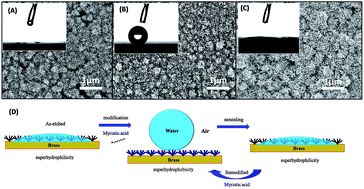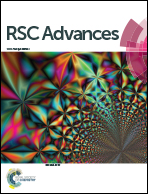Facile fabrication of a flower-like CuO/Cu(OH)2 nanorod film with tunable wetting transition and excellent stability†
Abstract
A flower-like CuO/Cu(OH)2 nanorod film on a brass substrate has been synthesized for the first time, with a tunable wetting transition and excellent stability. We devised a facile etching method utilizing an electrolyte containing K2S2O8 and KOH in this study. The growth process and the surface morphology of the flower-like CuO/Cu(OH)2 nanorods are well documented. Moreover, the surface wetting behavior is reversible between superhydrophilic and superhydrophobic. The as-prepared superhydrophilic surface can be converted to superhydrophobic by modification with myristic acid and can be changed back to superhydrophilic after annealing at 200 °C for 6 min. The wetting transition can be cycled more than 30 times and takes less than 10 min per cycle. We also discussed the wetting transition mechanism based on the surface composition analysis and the relevant theoretical model and investigated the abrasion resistance and flush resistance. For the primary application, we propose that a water-drop collecting device based on a large-scale and complex superhydrophobic surface would show an excellent performance.


 Please wait while we load your content...
Please wait while we load your content...